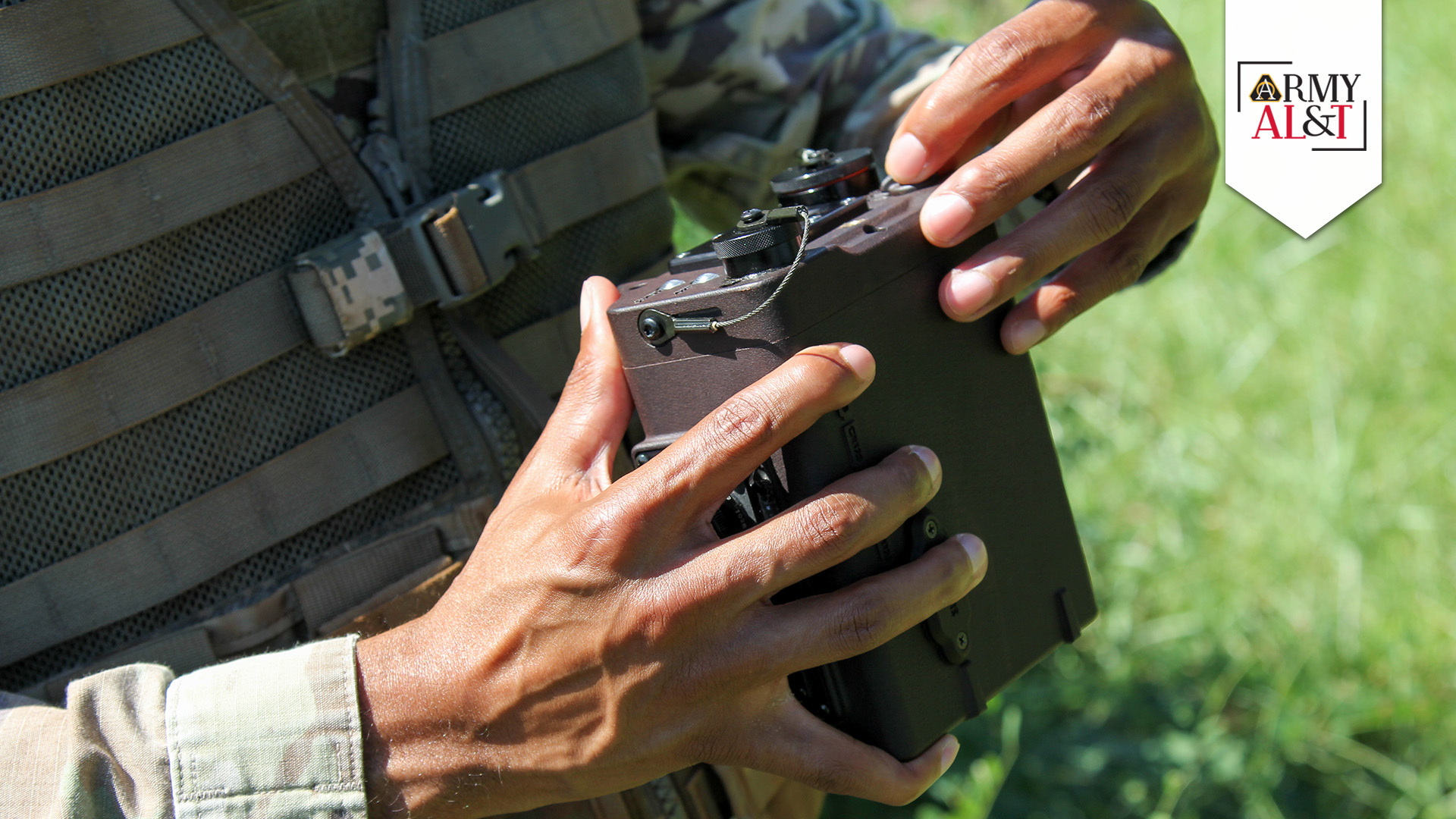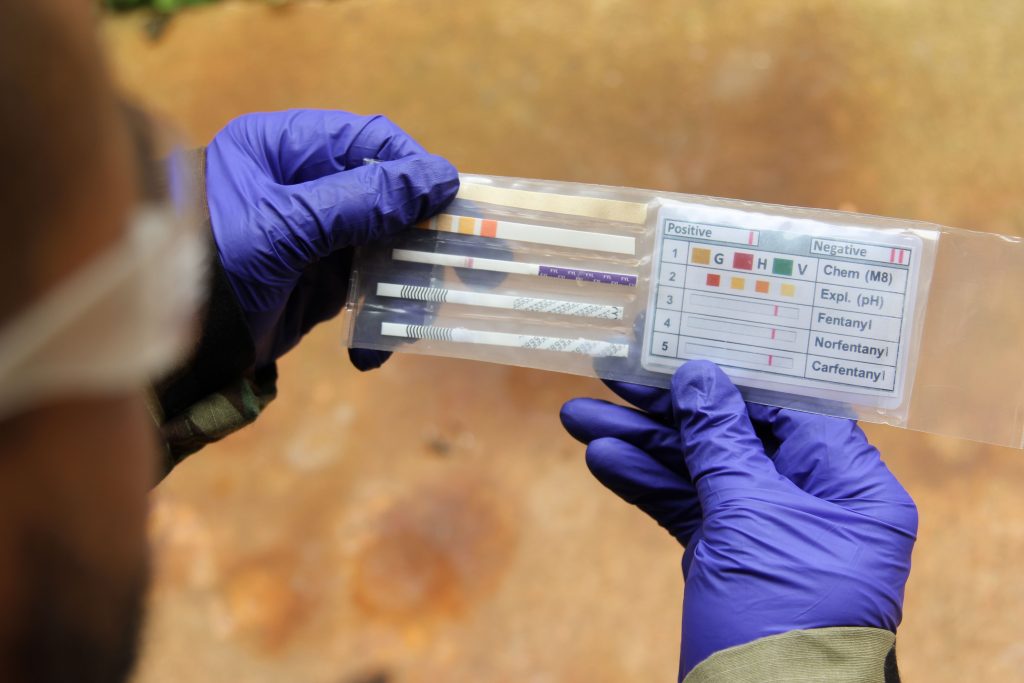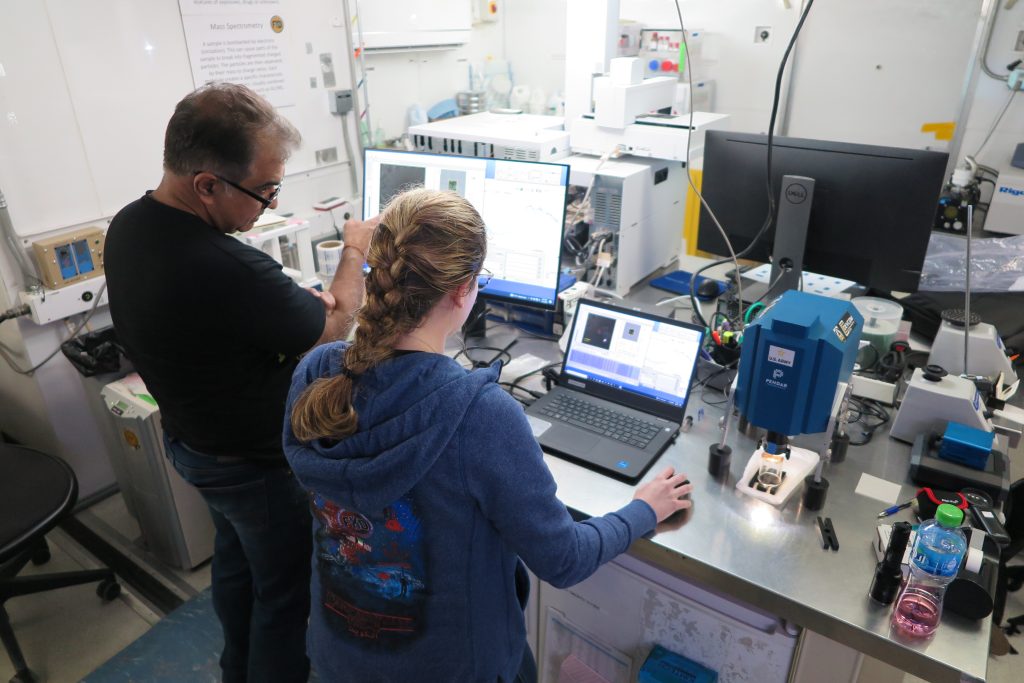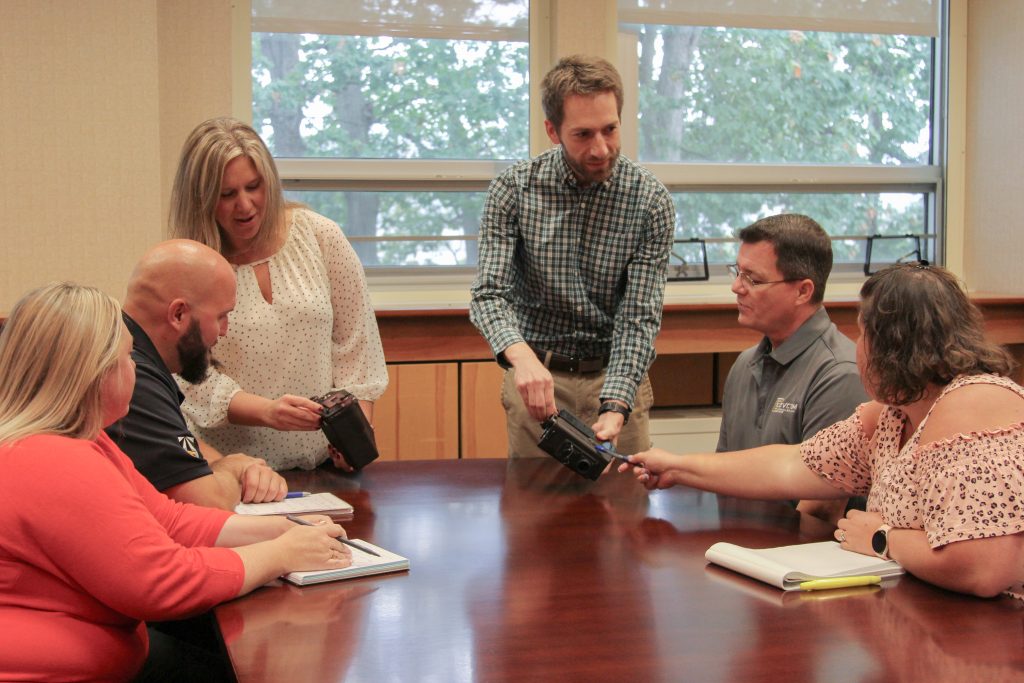
SHOW ’EM HOW IT’S DONE: A Soldier operates the wearable version of the Tactical Biological Detector in the field. (Photo by Gabriella White, U.S. Army Combat Capabilities Development Command Chemical Biological Center)
Technology development agreements drive chemical-biological defense efforts.
by Brian B. Feeney, Ph.D.
An easy-to-use chemical and biological agent sensor that fits in a pocket; a portable device for detecting a chemical agent left by fingerprints without diminishing the forensic value of those prints; and a real-time automated biological aerosol detector that’s small enough to be worn on a uniform are all innovations that are among the nearly 200 advances made possible in the past two years by technology transfer partnerships with the U.S. Army Combat Capabilities Development Command Chemical Biological Center (DEVCOM CBC).
U.S. defense research laboratories like DEVCOM CBC serve a vital role. They direct all their research toward developing technologies that will benefit the warfighter, and thereby the nation. Defense research laboratories cannot do it alone, however. They partner with industry for commercial development because it gets new technologies into the hands of the warfighter quickly and because it is required by law. Furthermore, the 2023 National Defense Strategy states that DOD “must be more proactive with its engagements with the private sector to make the right investments to capitalize on emerging technologies.”
The mission of executing that proactive engagement with industry falls to the center’s Technology Transfer Office (T2), which was established in 1986. With a staff of less than 10 with an eclectic set of backgrounds, T2 actively initiates agreements with industry to collaborate on applied research, product development and testing. It establishes contacts in industry by attending science conventions, monitoring trade journals, and by meeting directly with industry experts, DEVCOM CBC scientists and engineers. With this accumulated knowledge, T2 personnel serve as a central repository of commercial partnership knowledge for the entire center.
MAKE ME A MATCH
When a DEVCOM CBC research team arrives at the stage where commercial collaboration on its technology is the next step, T2 gets to work finding the right match with a private company. When the research team and the selected company arrive at an agreement in principle to work together, T2 digs into its toolbox. That toolbox includes cooperative research and development agreements, letters of intent, material transfer agreements, patent license agreements, technology support agreements, memorandums of agreement and memorandums of understanding.
The DEVCOM CBC research team and representatives of the private company select the best type of agreement for their circumstances and goals. Once an agreement is forged, the partner company reaps several benefits. DEVCOM CBC makes its intellectual property portfolio available, contributes its science and engineering expertise and provides access to its one-of-a-kind chemical biological research and testing infrastructure. In return, the partner company offers its own specialized expertise, ability to commercially manufacture and entrepreneurial energy.
The result is twofold. New chemical biological defense technologies get into the hands of warfighters faster, and industry, particularly technology startup companies, benefits from new business.
What is easy to miss among the legal agreements and the technology development is the human story behind every successful DEVCOM CBC commercial partnership. With each partnership comes a team of DEVCOM CBC researchers that sees the importance of meeting a real warfighter need and understand that partnering with the right company in the private sector will get the job done, going from applied research all the way to a fielded device. Keeping the warfighter better protected in the field is a team endeavor. Each partnership adds private industry entrepreneurs to the effort. They recognize the value of the research team’s new technology and appreciate the value of public-private sector partnership.

PROOF POSITIVE OR NEGATIVE
The Pocket Detection Pouch contains strips that change color in minutes to indicate the presence of chemical or biological agents as well as opioids. (Photo by Gabriella White, DEVCOM CBC)
FROM COUNTERTOP TO POCKET
Two DEVCOM CBC researchers, Jennifer Sekowski, Ph.D., and Kelley Betts, developed the Pocket Detection Pouch using seed money from an internal fund designed to test promising new ideas. It is a simple-to-use device that simultaneously tests for the presence of synthetic opioids and chemical and biological agents. It came about because Betts had a eureka moment in her kitchen. Her husband already had been deployed several times, and she wanted to find a way to make him safer by creating a field test for threat agents that would require no power source, provide quick results and fit in his pocket. What she and Sekowski came up with was a set of small channels inside a plastic bag that moves a liquid, sampled in the field and placed in the bag, over strips of paper that change color in the presence of agent. The paper reveals the presence of an agent based on the color change. “I questioned the traditional paradigm that threat agents can only be analyzed using a test tube or cassette,” said Betts. “I wondered if we could test using something different, like perhaps a pouch.”
During field testing starting in 2019, Betts could see that they had a hit on their hands. During a technology demonstration event at Camp Dawson, West Virginia, a Soldier told them that the Pocket Detection Pouch should be considered as a new DOD program of record because it has the ability to amplify current capabilities and can provide security forces with a quick fentanyl response without calling in hazardous material specialists. A member of the 79th Military Police Battalion at Fort Carson, Colorado, told them that they had “strong interest in PDP [Pocket Detection Pouch] as part of a field-forward kit with the swappable detection strips.”
With a better mousetrap in hand, DEVCOM CBC’s T2 found a disabled-veteran startup company uniquely qualified to advance this technology. It is run by a former Army medic, Yusuf Henriques, who founded the genomics company IndyGeneUS in 2021. Henriques was immediately interested in the cleverness of the Pocket Detection Pouch and wanted to partner with the center. The T2 team sprang into action and created a letter of intent for a research partnership, which Henriques was able to use to raise startup funds. In June 2023, DEVCOM CBC and IndyGeneUS entered into a cooperative research and development agreement (CRADA), and together they are refining the Pocket Detection Pouch design and gearing up for an initial low-rate production to allow for expanded field testing. “Partnering with IndyGeneUS is enabling us to move the Pocket Detection Pouch out of the laboratory and develop a commercial version that can be put into the field where more Soldiers can use it and help us make it an even better fit for their needs,” said Sekowski. Future applications are not limited to the armed forces and may include civilian first responders and citizens who were possibly exposed to hazardous materials.

TAKING A CLOSER LOOK
Ashish Tripathi, left, and project team member Evelyn Ligon, examine analytical results generated by the Portable Microscopy Chemical Detection System within minutes of hitting the object of interest with light. (Photo by Jason Guicheteau, DEVCOM CBC)
LIGHTER IS BETTER
The Portable Microscopy Chemical Detection System (PMCDS) is another technology borne of deployment. A senior DEVCOM CBC scientist returned from deployment in Afghanistan and presented a fingerprint sample on a substrate. He wanted to see if it was possible to identify traces of chemical agent on it without contacting or altering the forensic value of the fingerprint. This was a recurring problem he experienced at the frontlines during deployment. A team of DEVCOM CBC scientists, led by Jason Guicheteau, Ph.D., and Ashish Tripathi, Ph.D., responded to the challenge by figuring out how to shrink an existing nondestructive agent detection system from the size of a small refrigerator to the size of a breadbox weighing 10 pounds. It requires minimal training to use, and the system captures the fingerprint image, which it can send electronically to the FBI’s Integrated Automated Fingerprint Identification System for identification.
At the same time, the system can perform forensic analysis of any trace explosives and illicit drugs from residues found between the fingerprint grooves on that surface. Because the system is simply placed over the sample, the sample is never touched or altered in any way. The means of detection is so sensitive that microscopic deposits of a substance can be identified. It does this by hitting the substance with light. This technology is known as automated Raman microscopy. Raman occurs when an intense light source interacts with a molecule and produces a vibrational bond, much like a fingerprint, that can be used to identify what type of molecule it is.
While the technology was proven, the 80-pound detection device that existed at the time was not field-deployable. Getting it down to 10 pounds was going to require help from the private sector—they just needed the right partner. They found the ideal partner in Pendar Technologies, a small Cambridge, Massachusetts-based technology company that specializes in advancing intelligent chemistry systems. In 2017, DEVCOM CBC T2 created a CRADA so that both parties could work closely together on solving how best to shrink it down to 12.5% of its starting weight. “The partnership and exchange of ideas with Pendar Technologies has been crucial for advancing the evolution of the portable microscopy technology we originally envisioned,” said Guicheteau. “And it accelerated the timeframe for eventual fielding.”
By taking the system on the road and demonstrating its capabilities and potential, Guicheteau and Tripathi were able to obtain funding from DOD’s Irregular Warfare Technology Support Center and the United Kingdom Ministry of Defence. With the money in hand, and after months of hard work, they ended up creating the world’s smallest, most portable automated Raman microscope.
It received good reviews from the user community. Capt. Kyle Hallinan, laboratory director of the Joint Theater Forensic Analysis Center, said, “We are very excited to implement this technology as it compliments support to forensic science exploitation and force protection. Inside USAFRICOM’s theater exploitation laboratory, our chemists were able to use the technology to provide near real-time identification of micron-size particles of explosives and drugs in a significantly smaller package than our stationary laboratory equipment.”
Guicheteau and Tripathi are now readying the technology for production and anticipate delivering the devices to their first customer, the U.S. Army Criminal Investigation Directorate, in early 2024.

HOW-TO’S OF TACBIO
DEVCOM CBC scientists Aime Goad, center left, and Gary Kilper, center right, show Matt Jones, second from right, and his DEVCOM CBC Technology Transfer staff how to operate the wearable version of the TACBIO. (Photo by Gabriella White, DEVCOM CBC)
MAKING IT WEARABLE
The second-generation Tactical Biological Detector (TACBIO Gen II) was designed by a team of DEVCOM CBC scientists and engineers, led by Aime Goad and Gary Kilper, to be a lightweight, field-portable biological agent detection device. It can be used by warfighters and first responders alike to detect potential biological agent exposure. Generation II is a big improvement over the original 2008 version, TACBIO Generation I. First field tested in 2014, it reduced sample results time from 60 seconds to five seconds, reduced the weight from 3 pounds to 1 pound, and reduced the cost from $10,000 to $2,000. But never content to rest on their laurels, the team kept working on further refinements and greater technical sophistication, particularly greater miniaturization.
This ongoing research prepared the team to meet a very specific U.S. Coast Guard need. The Coast Guard wanted a miniaturized version of the TACBIO that can be clipped onto a uniform while on deck. To meet this requirement, Goad and Kilper had to find a private sector research partner to help complete the device’s refinements and scale it up for commercial production.
Scientists at Applied Research Associates (ARA), an employee-owned scientific research and engineering company with an office in Littleton, Colorado, were aware of the technology and eager to partner with Goad and Kilper’s team to create a wearable version of TACBIO for the Coast Guard. Goad put T2’s Matt Jones in touch with the company’s corporate counsel and together they established a CRADA. DEVCOM CBC and ARA collaborated on and produced the now-patented Wearable Biological Warfare Agent Detector, which is in use by the Coast Guard and receiving interest in licensing for larger-scale manufacturing. “Applied Research Associates proved itself to be a full partner in the two-year effort to miniaturize the TACBIO to meet the Coast Guard’s requirements,” said Goad. “By leveraging each other’s talents, we arrived at a prototype far faster than either partner could have working alone.”
CONCLUSION
In each of these cases, scientists at DEVCOM CBC saw the importance of meeting a real warfighter need and understood that partnering with the right company in the private sector would get the job done—going from applied research all the way to a fielded device. Each of these cases demonstrates that keeping the warfighter better protected in the field is a team endeavor.
“The efforts of our researchers and the center’s Technology Transfer team have really paid off for everyone,” said DEVCOM CBC Director Michael Bailey. “These partnerships not only shorten the time between a good idea and a new technology in the hands of warfighters, they also invigorate the economy and expand the nation’s chemical-biological defense industrial base.”
| PARTNER WITH THE PRIVATE SECTOR—IT’S THE LAW
The effort to make federal laboratories a resource for the private sector formally began with passage of the Stevenson-Wydler Technology Innovation Act in 1980. This law required federal laboratories to set aside a percentage of the laboratory budget specifically for technology transfer activities. This was followed by the Federal Technology Transfer Act of 1986, which established the Federal Laboratory Consortium, a U.S.-based network of federal laboratories. The consortium has an established forum dedicated to finding ways to transfer technology developed by its members to the private sector. The act also established cooperative research and development agreements (CRADAs) to negotiate licenses for patented inventions developed at the laboratory. In 1992, Congress passed the Small Business Research and Development Enhancement Act, creating mechanisms for small businesses to enter into joint ventures with federal laboratories. In 2015, DOD stood up the Defense Innovation Unit, whose mission was to make contracting with DOD easier for small businesses developing leading-edge technology. This was in response to a growing Silicon Valley-Pentagon divide that defense planners saw as damaging to national security in the face of China’s ability to adopt new commercial technologies with much greater agility. |
For more information. Go to https://www.cbc.devcom.army.mil.
BRIAN B. FEENEY, PH.D., is a public affairs specialist at the U.S. Army Combat Capabilities Development Command Chemical Biological Center, where he writes news and feature stories on the science and engineering achievements of the center’s researchers. He has written for the center since 2014. He holds a Ph.D. in risk communication from Temple University, an M.A. in communications from Cornell University, and a B.A. in history from Colorado College.


